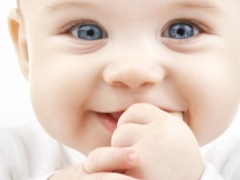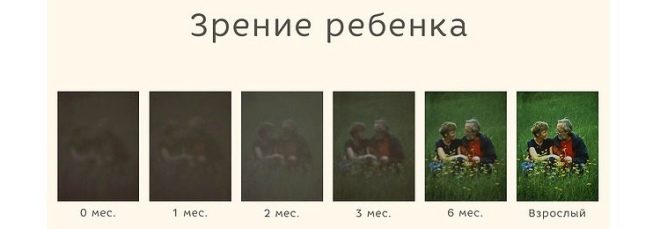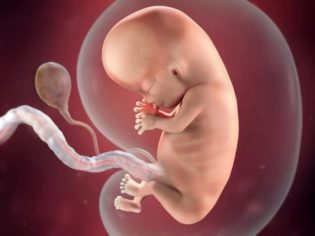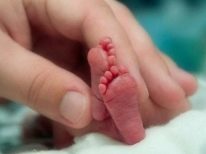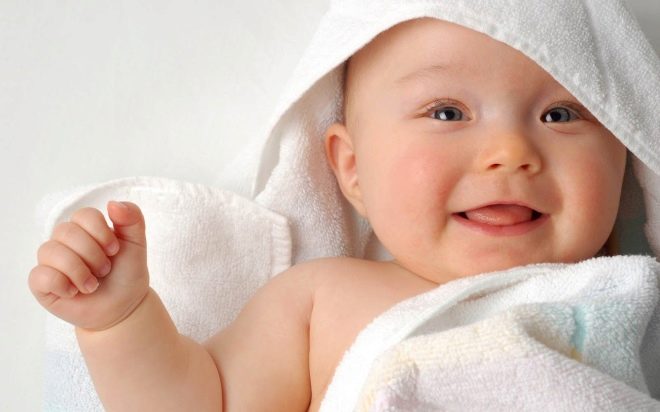Newborn eyesight
A newborn baby does not have good eyesight, and sometimes it even shocks parents with the fact that their eyes mow, cannot focus, they are clouded. Questions about whether the child is healthy, and whether he sees, are quite common causes of appeals to pediatricians. In this article we will tell you what are the features of the visual function in babies of the first year of life and how to determine whether the baby sees.
Special features
Baby sees the world around it is not as adults. This is easily explained in the first place by physiological reasons - the child’s eyes differ significantly in structure from the eyes of an adult. Children are not born with organs of sight that are fully adapted to this world and sufficiently formed. All without exception of crumbs in the 1st month of life visual acuity is extremely low. All that is for us a picture of the surrounding world, for a newborn - a set of spots of different illumination and intensity. His eyes are in a continuous process of formation.
The eyeballs of a newborn are significantly smaller in proportion to the eyeballs in an adult, and therefore the image of the baby is not received on the retina, but into the space behind it.
This explains why all infants suffer from physiological, long-sighted, completely normal for them. In the early days, the baby does not focus at all. He sees mostly black and white spots, only outlines and at an average distance of about 40 centimeters. But from the excellent distinguishes light and darkness. In response to a bright light source, the child may begin to blink, squint, try to close with a pen, shudder with the whole body, the baby may react to a too sharp and bright light with a disgruntled angry cry. These reflexes are called unconditional visual. They must be checked back in the maternity hospital.
There is a myth that the newborn's eyesight is inverted. This is not true. If there are no pathologies of the brain, gross congenital defects of its development, then the baby sees just like all other people. The inverted image is not peculiar to babies.
But many quite healthy babies, who were born only a couple of months ago, have a wide variety of eye movements, which parents sometimes take for strabismus, for nystagmus, and for other signs of poor vision. In fact, newborns and babies have very weak eye muscles, and therefore it is not surprising that one baby looks at you and the other looks a little to the side, no. This is a temporary phenomenon, which in the normal development of visual analyzers will disappear independently in a fairly short time.
In the first three years of life, the organs of vision of the baby undergo enormous dramatic changes. This process requires a reverent attitude on the part of adults, the elimination of all negative factors due to which vision can form with problems. In order to act correctly, moms and dads need to know about what processes and at what stages of development they take place, this will help preserve the health of the child and notice deviations in time if they are.
Stages of development
The eyes of the embryo begin to form at 8-10 weeks of pregnancy. It is important that at this moment mother is healthy, and no negative factors influence the correct tabulation of the organs of vision, optic nerve.Pathologies that occur during the period of being in the womb are rather difficult to correct, if they are amenable to it at all.
In his mother's belly, the baby distinguishes between light and darkness, demonstrates unconditional visual reflexes, but he does not see bright light, getting used to the darkened and dim atmosphere. After birth, the toddler needs to adapt to its new habitat conditions. Distinguish something else besides light, the baby begins at about 3 weeks after birth. It is at this stage that objective and color vision begins to form.
By the beginning of the second month of independent life, the baby can already have very little time to keep a glimpse of large bright and large objects that are no more than 60 cm away from him. By 3 months, the baby is able to follow the silent toy with his eyes for much longer. And the toy itself can now move left and right and up and down. The child repeats similar movements with eyeballs, turns his head toward the bright object of interest.
For half a year, stereoscopic vision is formed in children. The kid focuses on objects without any problems, watches them with his eyes, can reach out and take the toys in his hands.
Color perception is formed gradually - at first the kids begin to distinguish the red color and give preference to it. Then they see yellow. Green and blue are comprehended and realized last.
After 6 months, tots learn to see the far space. Stereoscopic vision allows them to see the world volumetric, full-fledged, and the improving capabilities of the body (he learns to sit, crawl, walk) gradually stimulates development cortex, which is also responsible for the accumulation of visual images. The kid learns to estimate the distance between objects, to overcome it, the color range in the second half of life also becomes more saturated.
Congenital physiological hyperopia, common to all babies, usually passes by 3 years. During this time, the eyeballs are actively growing in children, the eye muscles and the optic nerve are developing and improving. The organs of vision of the child become as similar as adults to only 6-7 years.
At no age stage does a child endure such dramatic changes and transformations in the organs of vision as in the first year of life.
Surveys
The first examination by a neonatologist children are still in the hospital. It allows with a high degree of accuracy to establish the majority of congenital pathologies of the organs of vision. These include retinopathy of the newborn, congenital cataract and glaucoma, optic nerve atrophy and other visual ailments. Serious congenital abnormalities are often accompanied by manifestations of such external signs as nystagmus (trembling and twitching of the pupils) and ptosis (omission of the eyelid). However, the examination in the maternity hospital cannot be considered 100% reliable, since many diseases, including those inherited genetically, develop only with time.
That is why it is so important that infants, especially premature babies, be promptly examined by an ophthalmologist. The first inspection always falls on the age of 1 month. At this age, the doctor is limited to the assessment of visual reflexes, including the light test on the pupil, as well as a general eye examination - the shape and size of the eyeballs, the pupils, the purity (uncomplicated) of the lens.
The next check for premature under the plan should be at 3 months, and then at half a year. For babies born on time, one check at 6 months is enough.
In six months, the doctor will be able to get an idea of the baby’s visual function in more detail. He will not only visually assess the state of his eyes with the help of devices, but also check their physical activity, focusing on objects, reaction synchrony, accommodation and refraction.The doctor will tell the parents of the six-month-old child with a high degree of accuracy whether the small squint in their offspring is functional and harmless or is it a pathological change that needs correction.
If the parents have doubts that the child sees well, the doctor may try to examine the vision of the crumbs using a special tablet. One half of the leaf in it is covered with black and white stripes, the second is white. Mom closes the baby one eye, and the doctor brings this sheet to the face. If the baby automatically starts looking at the striped part of the table, then he sees, and there is no reason for concern.
The doctor-oculist may also conduct the same study on the next scheduled examination, which should be carried out in 1 year. After one and a half years, the Orlova diagnostic table is used to assess visual acuity, and if violations are detected, the degree and severity of the problem is checked using special techniques and devices. After one and a half years, it is recommended to check the eyesight of the child 2 times a year.
How to check yourself?
Independently at home, it is quite difficult to check the vision of a newborn and an infant. However, there are symptoms that parents must pay attention to and consult a doctor as soon as possible, which will help to conduct a full and detailed examination in the clinic:
- The child was born in a family where close relatives have vision problems. With a high degree of probability, the baby will inherit the pathology, it should be monitored by an ophthalmologist as often as possible.
- The baby was born prematurely.
- At 1 month, the baby does not respond with constriction of the pupil.if you shine a flashlight in his face.
- After 3 months, the baby does not focus on bright big toys., reacts only to “sounding” rattles and tweeters, not noticing toys and objects that do not make any sounds.
- At the age of 4 months does not follow the toythat moves.
- At the age of 5-7 months, the baby does not recognize the faces of relatives and does not distinguish them from the faces of strangers, does not reach for toys, does not try to grab them with their hands.
- If purulent or other secretions appear from the organs of sight.
- If the eyeballs of a child have different sizes.
- If the pupils involuntarily move up and down or side to side, shivering finely.
- If the baby significantly "mows" with one eye.
- By the year the child does not pay attention to the birds on the street, on other fairly distant items.
All these signs can not independently speak about the possible pathology of visual analyzers, but are a very convincing reason to visit an oculist on an unplanned basis.
Development
Anatomical and physiological features of the development of vision in children of the first year of life (AFO) will prompt parents what to do and how to help develop the baby’s visual function. If the crumbs were brought from the maternity hospital and settled in a darkened room where there is little sunlight, then all the stages of the formation of vision can go with a significant delay. For newborns it is very important that the room is bright, so that there are no bright light sources and mirrors near the crib. Access to the crib should be made from all sides, so that the baby gets used to looking at people and objects both from the right and from the left.
In the first days and even weeks, the child does not need any toys, since he still will not see them properly. But as early as 3-4 weeks of life, you can attach a mobile to the bed or hang rattles. The main requirement that will help maintain the health of the baby’s eyes is the distance from the face to the toy. It should not be less than 40 centimeters.
For the development of the visual function, it will even be useful if a toy or a mobile device is lifted from the face of the child at a distance of 50-60 centimeters.
From one and a half months to the child it is possible to show black-and-white pictures consisting of their simple geometric elements. They can be found on the Internet and printed on sheets of A 4 format.Such simple activities contribute to the development of the optic nerve, eye muscles, the child learns to perceive contrasting images.
At first, it is better to use toys that sound; by 3 months it will be possible to switch to silent toys. The first rattles should not contain too many elements of all colors of the rainbow. In the center it is better to place the elements of red and yellow, and blue and green - to move as much as possible on the sides, their baby will learn to distinguish much later. The size of one element, which the baby’s eyes are able to distinguish more or less distinctly, should not exceed 5-6 centimeters.
Toys should be safe, because from the age of 4-5 months, the baby must take them in hand in order to make stable connections in the brain between tactile sensations and the shape and color of objects that they see with their eyes. As soon as the baby learns to crawl and sit, you need to give him freedom of movement. Stereoscopic vision will develop more quickly, if the pug can easily comprehend the surrounding space. With this, it is necessary to take all safety measures so that the crumb is not injured.
Walking is important not only because the child breathes fresh air outdoors, but also because sunlight is very useful for the formation and development of eyeballs and other structures of the organs of vision.
Prevention of vision problems
From the first days of a child’s life, it is important to ensure that he does not hurt his eyes. The nails of newborns and babies are very sharp, even with a slight regrowth, but because mom needs every day to ensure that they do not scratch. Older children should not be given sharp and small objects for the game with which they can damage the organs of vision. The baby must be taught not to rub his eyes, not to touch them with dirty hands. The child should not be in a smoke-filled and dusty room, since smoke and dust adversely affect not only the respiratory organs, but also the organs of vision.
If the eyes festered, inflamed, in any case do not need to self-treat them - bury breast milk or saliva. It is with such actions that serious bacterial complications begin, which often lead to partial loss of vision.
In all cases of redness or swelling of the eyes, the infant should be immediately shown to the doctor.
A child up to a year absolutely does not care what happens on a TV or computer. So, giving him gadgets or turning on cartoons makes no sense. In addition to the load on the organs of vision, cartoons at this age will not bring anything. Careful parents of babies under one year should play with the child in the sandbox and with soap bubbles. It is these games that most often cause inflammation in the organs of vision caused by mechanical irritation or chemical burn. Inflammation often affects the decrease in visual acuity.
This video - an indispensable tool for the development of vision in infants.
